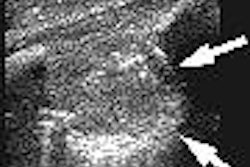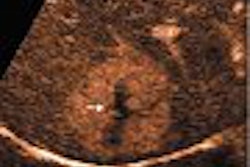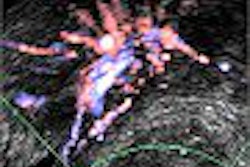(Radiology Review) Sonographic measurement and appearance of the testicular appendage can be used to diagnose torsion of the testicular appendage, according to Brazilian researchers.
Dr. Matteo Baldisserotto and colleagues at Hospital da Criança Conceição in Porto Alegre determined an upper limit of normal measurement for the testicular appendage, as well as normal and abnormal grayscale and Doppler appearances in a study recently published in the American Journal of Roentgenology.
Differentiating between torsed testis and testicular appendage is an important clinical challenge because of the high morbidity associated with torsion of the testis. Defining the size of normal and torsed testicular appendages with ultrasound imaging is a useful and safe diagnostic tool for determining torsion of testicular appendages, enabling conservative management and reduction in false-positive results for testicular torsion, the researchers stated.
Thirty-three male children with acute scrotal pain were preoperatively examined using ultrasound imaging. Torsion of scrotal contents was found in 27 patients and six had epididymitis. Twenty-two patients had torsion of the appendix testis, three had torsion of the testis, and two had torsion of the appendix epididymis.
Using grayscale and color Doppler, the team demonstrated the testicular appendage in 23 patients. Most of these patients had a torsed testicular appendage. "With the visualization of an appendix larger than 5.6 mm as the sonographic diagnostic criterion for torsion of a testicular appendage, sensitivity was 68.2%, and specificity was 100%," the authors wrote. There were two patients with epididymitis and enlarged appendix testis (16.0 mm and 9.2 mm), and one torsed appendix testis measuring 5 mm, which was not demonstrated on ultrasound.
The researchers described the sonographic appearances in 21 patients with torsed appendix testis as hyperechoic to the epididymis in 11 patients, hypoechoic in three, heterogenous in four, and isoechoic in three. "The two normal testicular appendages found in the patients with epididymitis were hypoechoic," they stated.
"The identification of a testicular appendage larger than 5.6 mm is suggestive of torsion. Therefore, depending on the patients' clinical conditions, these cases can be treated conservatively when an appendage larger than 5.6 mm is identified," the researchers concluded.
"Color Doppler Sonography of Normal and Torsed Testicular Appendages in Children"
Baldisserotto, Matteo, et al
Hospital da Criança Conceição, Ministério da Saúde - Brazil, Eca de Queiroz, 384 Apt. 502, Porto Alegre, RS, Brazil, 90.670-020.
AJR 2005 (April); 184:1287-1292
By Radiology Review
April 21, 2005
Copyright © 2005 AuntMinnie.com



















